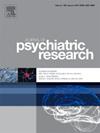Prevalence, contributing factors, and clinical impact of apathy in Parkinson's disease
IF 3.2
2区 医学
Q1 PSYCHIATRY
引用次数: 0
Abstract
Objective
Apathy appears as a common neuropsychiatric symptom in Parkinson's disease (PD). This study aimed to investigate its prevalence, associated contributing factors, and clinical impact by a meta-analysis approach.
Methods
Studies published before October 2024 were retrieved from PubMed, Web of Science, and Google Scholar. Data were analyzed using STATA 12.0 software.
Results
The pooled prevalence of apathy in PD was 37 % [95 % confidence interval (CI): 32 %–42 %]. Compared with PD patients without apathy (PD-NA), PD patients with apathy (PD-A) were older [standard mean difference (SMD) = 0.25, 95 % CI: 0.19 to 0.32], more likely to be male (SMD = 1.06, 95 % CI: 1.00 to 1.12), and had lower educational levels (SMD = −0.29, 95 % CI: −0.40 to −0.18). Clinically, PD-A showed worse motor performance with higher scores on the Unified Parkinson's Disease Rating Scale III (SMD = 0.52, 95 % CI: 0.38 to 0.66) and Hoehn and Yahr stage (SMD = 0.29, 95 % CI: 0.13 to 0.46). They also exhibit more general cognitive impairment (SMD = −0.37, 95 % CI: −0.47 to −0.27), and greater depressive symptoms (SMD = 0.88, 95 % CI: 0.70 to 1.06). Therapeutically, PD-A required increased levodopa doses (SMD = 0.20, 95 % CI: 0.07 to 0.32) and more frequent use of antidepressants (SMD = 1.64, 95 % CI: 1.15 to 2.36).
Conclusions
Apathy is prevalent in PD and associated with greater motor, cognitive, and emotional dysfunction. Early identification and targeted interventions for apathy would improve the disease management and enhance the quality of life for PD patients.
帕金森病患者冷漠的患病率、影响因素和临床影响
目的冷漠是帕金森病(PD)常见的神经精神症状。本研究旨在通过荟萃分析方法调查其患病率、相关影响因素和临床影响。方法从PubMed、Web of Science和b谷歌Scholar检索2024年10月前发表的研究。数据分析采用STATA 12.0软件。结果PD患者冷漠的总患病率为37%[95%可信区间(CI): 32% - 42%]。与无冷漠PD患者(PD- na)相比,冷漠PD患者(PD- a)年龄较大[标准平均差(SMD) = 0.25, 95% CI: 0.19 ~ 0.32],男性居多(SMD = 1.06, 95% CI: 1.00 ~ 1.12),受教育程度较低(SMD = - 0.29, 95% CI: - 0.40 ~ - 0.18)。临床上,PD-A表现出较差的运动表现,在统一帕金森病评定量表III (SMD = 0.52, 95% CI: 0.38至0.66)和Hoehn和Yahr分期(SMD = 0.29, 95% CI: 0.13至0.46)上得分较高。他们还表现出更普遍的认知障碍(SMD = - 0.37, 95% CI: - 0.47至- 0.27)和更严重的抑郁症状(SMD = 0.88, 95% CI: 0.70至1.06)。在治疗上,PD-A需要增加左旋多巴剂量(SMD = 0.20, 95% CI: 0.07至0.32)和更频繁地使用抗抑郁药(SMD = 1.64, 95% CI: 1.15至2.36)。结论病理在帕金森病患者中普遍存在,并伴有较大的运动、认知和情绪功能障碍。冷漠的早期识别和有针对性的干预可以改善PD患者的疾病管理,提高患者的生活质量。
本文章由计算机程序翻译,如有差异,请以英文原文为准。
求助全文
约1分钟内获得全文
求助全文
来源期刊

Journal of psychiatric research
医学-精神病学
CiteScore
7.30
自引率
2.10%
发文量
622
审稿时长
130 days
期刊介绍:
Founded in 1961 to report on the latest work in psychiatry and cognate disciplines, the Journal of Psychiatric Research is dedicated to innovative and timely studies of four important areas of research:
(1) clinical studies of all disciplines relating to psychiatric illness, as well as normal human behaviour, including biochemical, physiological, genetic, environmental, social, psychological and epidemiological factors;
(2) basic studies pertaining to psychiatry in such fields as neuropsychopharmacology, neuroendocrinology, electrophysiology, genetics, experimental psychology and epidemiology;
(3) the growing application of clinical laboratory techniques in psychiatry, including imagery and spectroscopy of the brain, molecular biology and computer sciences;
 求助内容:
求助内容: 应助结果提醒方式:
应助结果提醒方式:


